OpenAI’s new ChatGPT Agent delivers a significant leap in AI-powered productivity, allowing users to offload multi-step digital tasks to an intelligent system that operates within its own virtual computer. This rollout moves beyond simple chatbot conversations, introducing a tool that can navigate websites, analyze data, interact with external apps, and produce editable documents or reports—all according to user instructions.
Unified Agentic System for Complex Task Automation
ChatGPT Agent builds on the strengths of OpenAI’s previous Operator and Deep Research tools, combining the ability to interact with web interfaces (clicking, typing, scrolling) and to synthesize large volumes of information into actionable insights. The result is a unified agentic system that can handle workflows such as briefing you on meetings by scanning your calendar and relevant news, planning and purchasing ingredients for meals, or generating comprehensive competitor analysis slide decks.
Unlike earlier models that specialized in either web interaction or deep analysis, ChatGPT Agent fluidly transitions between reasoning and action. It decides which tools to use—such as a visual browser, text-based browser, terminal, or direct API access—based on the requirements of each task. This flexibility allows it to efficiently complete requests that previously required manual effort or multiple disconnected tools.
Proactive Task Completion with User Oversight
One of the most notable features is the agent’s ability to carry out tasks independently while maintaining user control. Before taking any consequential action—such as making a purchase or sending an email—the system prompts for explicit user confirmation. Users can also interrupt, take over the browser, or halt a task at any time, ensuring that sensitive steps never proceed without oversight.
For recurring needs, the agent supports scheduling tasks to run automatically. For example, generating a weekly metrics report every Monday morning can now be automated, reducing repetitive manual work.
Integration with Apps and Connectors
ChatGPT Agent supports connectors, allowing it to integrate with popular services like Gmail and GitHub. Once authenticated, the agent can access relevant data—such as summarizing your inbox or checking your calendar—to inform its actions. The system prompts for login when deeper access is required, and it preserves privacy by not storing user credentials or sensitive input data beyond what’s necessary for the session.
Benchmarks and Performance Improvements
OpenAI reports that ChatGPT Agent achieves state-of-the-art results on several industry benchmarks. On Humanity’s Last Exam, which tests expert-level reasoning across diverse subjects, the agent model achieved a pass@1 score of 41.6—significantly higher than prior models. For complex math problems on the FrontierMath benchmark, its 27.4% accuracy with tool use outpaces previous offerings. In real-world tasks like spreadsheet editing (SpreadsheetBench), the agent scored more than double the accuracy of Microsoft’s Copilot in Excel when handling direct .xlsx files.
These results indicate meaningful improvements in the agent’s ability to complete knowledge work, from financial modeling to data analysis, at a level comparable to or better than human experts in many cases.
Safety, Privacy, and Risk Mitigation
With expanded capabilities come new risks. OpenAI has implemented a multi-layered safety stack for ChatGPT Agent, including:
- Mandatory user confirmation for actions with real-world consequences.
- Active supervision (“Watch Mode”) for critical tasks, such as sending emails or accessing financial sites.
- Automatic refusal of high-risk tasks (e.g., bank transfers).
- Robust privacy controls, allowing users to delete browsing data and log out of all sessions with a single click.
- Real-time monitoring and classifiers to detect and block prompt injection attacks, which could otherwise manipulate the agent’s behavior.
OpenAI has also disabled the agent’s memory feature for now, reducing the risk of data exfiltration via prompt injection. The company is collaborating with external biosecurity and safety experts to stress-test and refine these safeguards, especially given the model’s designation as “high capability” in sensitive domains under OpenAI’s Preparedness Framework.
Availability and Access
ChatGPT Agent is rolling out to Pro, Plus, and Team users first, with Pro users receiving access immediately and others following over the next few days. Enterprise and Education plans will gain access in the coming weeks. Usage is capped at 400 messages per month for Pro users and 40 for Plus and Team users, with additional credits available for purchase. Access is not yet available in the European Economic Area or Switzerland, though OpenAI is working to expand regional support.
How to Activate ChatGPT Agent
Step 1: Open ChatGPT and select the tools dropdown from the message composer. Choose agent mode to enable the new capabilities within any conversation.
Step 2: Describe your desired task in natural language—such as requesting a research report, scheduling meetings, or creating a slideshow. The agent will begin processing, providing on-screen narration of its actions for transparency.
Step 3: If authentication or additional permissions are needed, the agent will prompt you to log in or approve the action. You can pause, stop, or intervene at any stage to adjust the workflow or review progress.
Step 4: For recurring tasks, schedule them to run automatically by specifying the frequency and parameters within the chat.
Step 5: After completion, review the output—such as editable slideshows, spreadsheets, or summaries. Make any necessary edits, or export the results as needed.
ChatGPT Agent marks a major upgrade in digital productivity, streamlining complex workflows while keeping user oversight front and center. As OpenAI continues to refine its capabilities, this agentic model sets a new standard for practical AI assistance.


